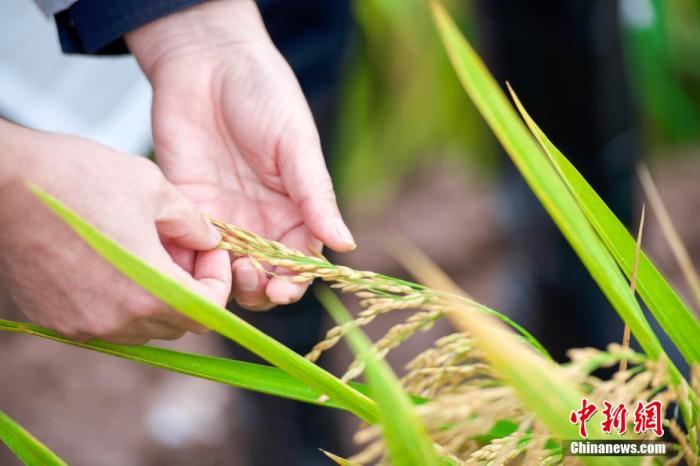China News Service, Hengyang, October 17 (Reporter Lu Yi and Xu Zhixiong) On October 17, at the Zimuchong Base of Qingzhu Village, Xiangyangqiao Street, Hengnan County, Hunan Province, a demonstration demonstration of a double-season rice yield of 1500 kg per mu in the southern rice area in 2021 The yield test and acceptance showed that the average yield per mu of late rice was 936.1 kg.
In addition, the early rice yield of the base measured in July is 667.8 kilograms per mu, and the annual yield of rice per mu is 1603.9 kilograms.
This is the highest yield per mu in the double-season rice area in southern China so far.
On October 17, at the third-generation hybrid rice experimental demonstration base in Hengnan County, Hunan Province, the Hunan Agricultural Society organized experts to test the yield of the third-generation late hybrid rice combination "Sanyou No. 1" developed by Yuan Longping's team.
Academician Xie Huaan of the Chinese Academy of Sciences announced the results on the spot. In addition, the early rice "Zhuliangyou 168" measured at the base in July had a yield of 667.8 kg per mu. The annual yield per mu exceeded 1,600 kg, reaching 1603.9 kg.
The picture shows the mature third-generation hybrid rice.
Photo by Yang Huafeng
On December 20, 2020, Academician Yuan Longping deployed the super-high-yield research work in 2021 during the southern propagation period in Hainan, and proposed to implement double-cropping rice production in Fujian, Guangdong, Guangxi, Hainan, Hunan and other double-cropping rice areas with a yield of 1500 kg per mu. Research and Demonstration (referred to as the "Three Thousand Jin Project"). According to the different ecological regional conditions of the southern rice regions, the key varieties are mainly super hybrid early rice, and the "Chaoyouqian" and No. Rice combinations with major breakthroughs in yield potential, such as three-generation hybrid late rice combinations.
The Hengnan County Demonstration Base is one of the key points for Hunan's double-cropping rice yield of 1500 kg per mu.
According to the experimental and demonstration technical plan formulated by the Hunan Hybrid Rice Research Center, the early rice variety in this base is the hybrid rice "Zhuliangyou 168", and the late rice variety is the third generation hybrid rice "Sanyou No. 1".
In 2020, the base achieved a double-season annual yield of over 1500 kg per mu for the first time.
"Planting the same varieties and achieving the expected yield target for two consecutive years in the same ecological area means that the double-cropping yield target of 3000 jin per mu in the southern rice region has been achieved." said Li Jianwu, director of the cultivation office of the Hunan Hybrid Rice Research Center.
Since 2019, the Hengnan County Demonstration Base has undertaken the super-high-yield experimental demonstration of the third-generation hybrid rice new combination developed by the team of Academician Yuan Longping.
For three consecutive years, the single-season late rice production of "Sanyou No. 1" has been tested and achieved an average yield of 1046.3 kg, 911.7 kg and 936.1 kg per mu.
The base is 78 meters above sea level and covers an area of 30.5 acres. The soil fertility level is medium and belongs to ordinary ecological conditions in rice cultivation conditions.
According to Li Jianwu, "Sanyou No. 1" has experienced low temperature and rainy weather in 2020 at the base and sustained high temperature weather in the later growth period of this year, and still achieves a good yield, which proves that the variety has good adaptability.
The next step will be to summarize successful experience and carry out a larger area of promotion.
On the same day, the Hunan Society of Agriculture organized an expert group composed of experts from South China Agricultural University, Fujian Academy of Agricultural Sciences, Rice Research Institute of Anhui Academy of Agricultural Sciences, Hunan University, Hunan Normal University and other units to conduct mechanical inspection and production of the demonstration varieties of the base.
(over)

